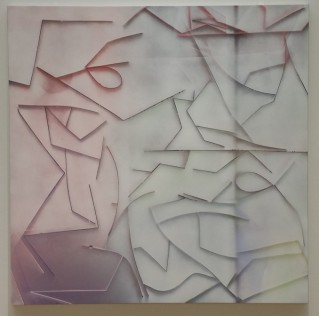Walker Art Gallery, until 27 November, free
Back at the start of July I wrote this piece on the history of the John Moores Painting Prize. I wrote about the Prize because I admire its commitment to championing progress in painting. The more I review and write, the more I recognise that painting is still my favourite art form. For me, a painting draws you into the world it wants to you be part of, and effects your emotions, in a way that sculpture or video doesn’t. But I did write with some trepidation: I hadn’t seen the 2016 Prize show yet, and it could have been terrible.

playpaint, Double Science Fiction
Luckily, I had nothing to worry about: it’s a cracker.
To start with, it’s a great showcase for why you should go to galleries to see paintings ‘in the flesh’. I’m not going to make this piece about the Prizewinners, having having mentioned them extensively on my last blog and Instagram. But having seen them in advance, my mind was changed about which of these paintings was my favourite. Seeing the real thing of Michael Simpson’s Squint – the overall prizewinner – helped me recognise exactly why it had been chosen as the winner. On PDF I had thought it was quite ordinary, to be honest. But on the real canvas you pay much more attention to the clean lines and how your eye is led up towards the squint hole, leading you to ask questions about “what’s out there?”.

Ira Hoffecker, Camp Moschendorf II
The paintings seem to have been hung in a loosely thematic way – the texture paintings, the linear paintings, the pattern paintings. If this sounds as though it may get repetitive, what it actually achieves is to make you realise how much creativity and innovation there is in painting. The artists may use broadly similar styles, but each painting is so different from the others which hang around it. For example, each of what I referred to as “the texture paintings” uses the 3D essence of paint to create a different effect within their work.
Interestingly, though, there aren’t many figurative works, which I think people associate with the medium of painting. If there could be said to be one (again, very loose) theme here, it’s that many of the paintings are about exploring depth and space. If this is the direction modern painting is going in, I like it.
If I wished I could easily spend this whole post telling you about my favourite pieces in the show, but I’m not going to. The paintings I have shown here have been chosen for their diversity, rather than necessarily my personal preferences… This is because if you go and see the show for yourself, it’s highly likely you will have your own favourites. I would advise you to take time to look at each painting on its own – the largest and most initially eye-catching may not ultimately be your favourites.

Lang Suilong, Fundamental Tool
The final space in the show is dedicated to exhibiting the prizewinners of the John Moores Painting Prize China. I admit that I don’t know much about the Chinese art scene, and so I didn’t really know what to expect. What I got was a room of good paintings, and I thoroughly admired the 1st prizewinner, Lang Suilong’s Fundamental Tool. Made using dust to create the outline of a spade, it conveys a message about the changing shape of industry and agriculture. The spade has now been rescued from its abandonment – is this an optimistic outlook on the value of human labour, a call to go back to the land?
The John Moores Painting Prize show is a partner exhibition of the Biennial, but is on for over a month longer. With autumn approaching and minds already turning to potential indoor activities, I strongly recommend you visit this show to bring some colour into the darkening days.
P.S: I feel it’s worth mentioning that on the day I visited the staff in the gallery were the friendliest and most helpful I’ve come across in any museum in a long time, who made the visit extra pleasurable.

1 thought on “Bringing it up to date: the 2016 John Moores Painting Prize”